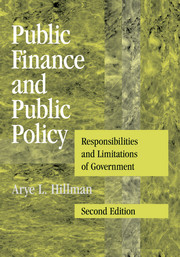Book contents
- Frontmatter
- Contents
- Preface to the Second Edition
- 1 MARKETS AND GOVERNMENTS
- 2 INSTITUTIONS AND GOVERNANCE
- 3 PUBLIC GOODS
- 4 PUBLIC FINANCE FOR PUBLIC GOODS
- 5 MARKET CORRECTIONS
- 6 VOTING
- 7 SOCIAL JUSTICE
- 8 ENTITLEMENTS
- 9 CHOICE OF TAXATION
- 10 THE NEED FOR GOVERNMENT
- TOPICS FOR DISCUSSION
- Author Index
- Subject Index
- References
5 - MARKET CORRECTIONS
- Frontmatter
- Contents
- Preface to the Second Edition
- 1 MARKETS AND GOVERNMENTS
- 2 INSTITUTIONS AND GOVERNANCE
- 3 PUBLIC GOODS
- 4 PUBLIC FINANCE FOR PUBLIC GOODS
- 5 MARKET CORRECTIONS
- 6 VOTING
- 7 SOCIAL JUSTICE
- 8 ENTITLEMENTS
- 9 CHOICE OF TAXATION
- 10 THE NEED FOR GOVERNMENT
- TOPICS FOR DISCUSSION
- Author Index
- Subject Index
- References
Summary
In this chapter we shall study market corrections due to externalities and paternalism. Section 1 describes prospects for private resolution of externalities. Section 2 considers resolution of externalities by government. Section 3 considers paternalistic public policies.
An externality is a cost or benefit not expressed in a market and therefore not internalized in buyers' or sellers' market decisions.
Whereas externalities arise when people's behavior or decisions affect others:
Paternalistic public policies are a response to the perception that people are making decisions that harm themselves or are failing to make decisions from which they would benefit.
We shall see, however, that paternalism can also arise with regard to what some people do to other people.
Externalities and Private Resolution
As we did with public goods, we first describe attributes of externalities and investigate outcomes through private voluntary action without government. We again begin using Robinson Crusoe for illustration.
Attributes of externalities
Robinson Crusoe alone on the island fishes in a stream. Crusoe has no formal property rights to the fish in the stream. Absence of property rights does not matter as long as Crusoe is alone on the island. When another person arrives and sets up a factory upstream that pollutes the water in the stream in which Crusoe fishes, the stream no longer supports the same number of fish and Crusoe incurs a loss. The owner of the factory has imposed a negative externality on Crusoe.
- Type
- Chapter
- Information
- Public Finance and Public PolicyResponsibilities and Limitations of Government, pp. 307 - 404Publisher: Cambridge University PressPrint publication year: 2009



